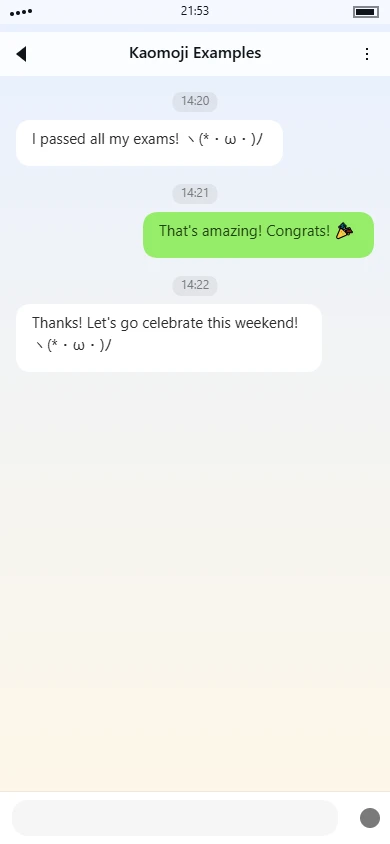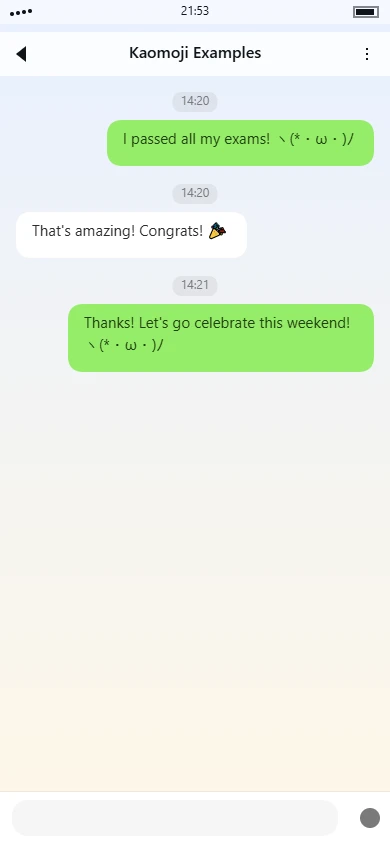(¬‿¬ ) kaomoji Meaning | Usage Tips

Overview
The kaomoji (¬‿¬ ) presents a distinctive facial expression characterized by asymmetrical eyes and a subtle smirk. The left eye is formed by the character ¬, which resembles a half-closed or squinting eye, while the right eye uses the curved symbol ‿ to create a more open, rounded appearance. This contrast in eye shapes creates a sense of visual imbalance that contributes to the expression's overall effect. The mouth is represented by the closing parenthesis ), positioned slightly off-center to the right, which gives the impression of a lopsided smile. The entire expression is enclosed within parentheses that serve as the face's outline, with a small space before the closing parenthesis that adds to the casual, informal feel of the kaomoji.
Symbol Breakdown
-
¬ (left eye): This character, derived from the logical negation symbol, functions visually as a half-closed eye. Its diagonal orientation and partial closure suggest a squinting or winking motion, which often conveys skepticism, amusement, or knowingness in kaomoji expressions.
-
‿ (right eye): Known as the undertie or inverted breve, this curved symbol creates an open, rounded eye appearance. Its smooth arc contrasts with the angular left eye, establishing an asymmetrical gaze that feels intentionally unbalanced rather than accidental.
-
) (mouth): The closing parenthesis serves as a simple smiling mouth, positioned to the right of the facial structure. Its curvature suggests a subtle smirk rather than a full smile, and its offset placement enhances the expression's casual, slightly mischievous quality.
-
Parentheses framework: The opening and closing parentheses ( ) form the basic face shape, with the left parenthesis starting the expression and the right parenthesis completing it after a small space. This spacing creates a relaxed composition that doesn't feel tightly constructed.
Emotion & Aesthetic Analysis
This kaomoji typically conveys a knowing, sly, or mischievous expression. The combination of the squinting left eye and the subtly smirking mouth suggests someone who has secret knowledge or is being playfully deceptive. The asymmetry between the eyes creates a side-eye effect, as if the character is looking at something or someone with mild suspicion or amusement while trying to appear innocent.
In terms of usage context, (¬‿¬ ) often appears in situations involving subtle teasing, inside jokes, or when someone is being deliberately ambiguous about their intentions. It carries a lighter, more playful tone compared to more overtly suspicious kaomoji like (¬_¬) or ( side-eyes ), and feels less intense than fully sinister expressions. The expression manages to communicate knowingness without being overtly confrontational or aggressive, making it suitable for casual digital conversations where subtle emotional nuance is desired.
Tag categories
Use tags to quickly understand this kaomoji.
Usage guide
Usage Guide for (¬‿¬ )
The (¬‿¬ ) kaomoji represents a classic expression of playful mischief, subtle teasing, and knowing amusement in digital communication. Characterized by its sly, closed-eye smile and slightly tilted head, this emoticon conveys a range of nuanced emotions from lighthearted joking to clever scheming. It's particularly effective for situations where you want to show you're in on a secret, gently poke fun at someone, or express that you have an ulterior motive—all while maintaining a friendly and non-threatening tone. This kaomoji thrives in casual online environments where humor and personality shine through, making it a favorite in gaming communities, social media banter, and friendly group chats where everyone understands the playful context.
Common Use Cases
- When teasing a friend about their obvious crush on someone
- Responding to someone who just told a slightly exaggerated story
- Playfully hinting that you know something others don't in a group chat
- Reacting to a friend's questionable life decision with affectionate judgment
- Accompanying a clever solution to a problem that others overlooked
- Expressing smug satisfaction after winning a friendly bet or game
- Signaling that you're about to share some juicy gossip
- Reacting to someone's transparent excuse with amused skepticism
- Adding playful tension to a conversation about future plans
- Responding to romantic advances with coy acceptance
- Expressing that you've figured out someone's secret recipe or technique
- Reacting to corporate jargon with subtle irony in work chats
Example Conversations
-
Friend A: I might be five minutes late... or thirty Friend B: (¬‿¬ ) Sure, "five minutes"
-
Gamer A: How did you complete that level so fast? Gamer B: Let's just say I discovered some interesting shortcuts (¬‿¬ )
-
Colleague A: The boss wants those reports by tomorrow Colleague B: Good thing I finished them last week (¬‿¬ )
-
Friend A: I swear I'm not buying any more plants Friend B: That's what you said before the last three plant shops (¬‿¬ )
-
Partner A: What are you planning for my birthday? Partner B: Wouldn't you like to know (¬‿¬ )
-
Group Chat Member: Who ate the last piece of cake? You: I have no idea what you're talking about (¬‿¬ )
Important Considerations
- Avoid using this kaomoji in formal emails, professional correspondence, or serious discussions where its playful tone might be misinterpreted as disrespectful or unprofessional
- Be mindful that the mischievous connotation can sometimes be read as passive-aggressive if the recipient doesn't know you well or if the context is already tense
- In cross-cultural communication, some may interpret the closed eyes as dishonesty or avoidance rather than playful teasing, so consider your audience carefully
- While generally lighthearted, this expression carries more sarcastic weight than simple smiling kaomojis, so use it sparingly with people who might take it literally
- The effectiveness of this kaomoji depends heavily on established rapport—it works best with friends and close acquaintances who understand your humor style
This kaomoji has become particularly popular in gaming communities and anime-focused spaces, where it often appears in reaction to clever strategies or inside jokes. Its versatility makes it equally at home in Twitter threads, Discord servers, and casual messaging apps where personality-driven communication is valued.
Usage examples
Real conversation samples that feature this kaomoji.

Example 1

Example 2
Related kaomoji
You might also enjoy these kaomoji.